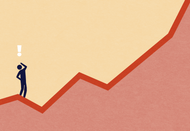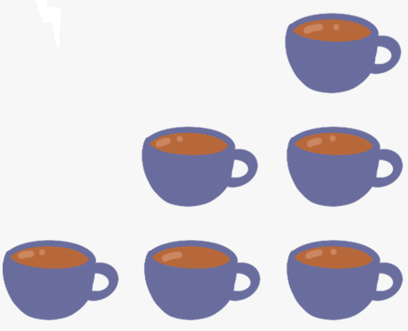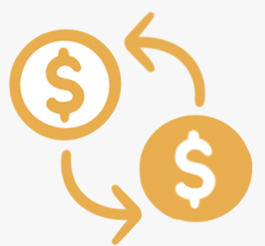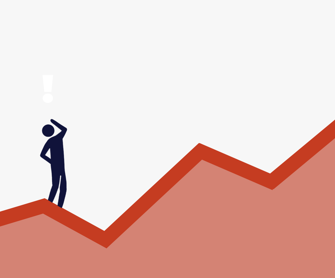Coffee Prices : The Perfect Storm
Posted by Villino Coffee Roasters on 6th Mar 2025

Coffee Prices: Uncharted Territory
If you've been following the news, you’ve probably seen the headlines:
"Coffee prices soar to all-time highs."
"Your daily brew is about to get more expensive."
"Your flat white will soon cost $10"
Clickbait? Maybe the last one—but these headlines reflect a real and unprecedented shift in the coffee industry. Prices have entered uncharted territory, and we’re all in for a ride.
In the past 12 months, the price of coffee on the commodity futures market—what the industry calls the "C-Price"—has more than doubled (we'll dive deeper into what this is later). But what does that mean for your morning coffee, and why are prices rising so dramatically?
What’s Driving the Surge? A Perfect Storm.
At its core, rising prices are a result of demand exceeding supply. A perfect storm of factors has created a volatile market:
|
|
Climate change reducing supply This is the big one. Severe frosts and droughts in Brazil, the world’s largest coffee producer, have drastically reduced supply. Vietnam, the second-largest producer and key supplier of Robusta beans, faces erratic weather patterns like prolonged droughts and excessive rainfall, impacting yields. As coffee trees struggle to survive, production declines. |
||
|
|
Rising demand: We all agree coffee is delicious, and people around the world are catching on and drinking more than ever before. New markets are emerging, especially in Asia, increasing competition for available beans. |
||
|
|
Weak Australian dollar: Coffee is traded in USD, so a weaker Aussie dollar means higher costs for Australian roasters and importers. |
||
|
|
Financial speculation: Traders in the futures market—who have no intention of actually handling a single bean—are betting on supply shortages and price movements, pushing prices even higher.
Geopolitical tensions and tariffs: Political instability and the looming threat of trade barriers add uncertainty, making prices volatile. |
||
|
|
Increased production and shipping costs: Everything from fertilizers to labour has become more expensive, and supply chain disruptions mean longer shipping times and higher freight costs. |
![]()
![]()
![]()
C-Price Crash Course – The Market Behind Your Morning Coffee
The C-Price is the global benchmark for Arabica coffee prices, traded on the Intercontinental Exchange (ICE) in U.S. dollars per pound under the symbol “KC”. It represents the base price for raw, unroasted Arabica coffee and is a critical reference point for coffee producers, exporters, importers, and roasters worldwide.
How Is the C-Price Determined?
The C-Price fluctuates daily based on the global futures market, where traders buy and sell contracts for coffee to be delivered at a future date. It reacts to supply and demand factors (e.g., weather, crop yields, political events, consumer demand), and lately it has gone wild (more on why later).
Two key players influence these price movements:
Hedgers (Producers & Buyers): Farmers and coffee businesses use the futures market to lock in prices ahead of harvests, helping them manage financial risk. A producer, for example, might sell a futures contract to secure a minimum price for their upcoming crop.
Speculators: Investors who don’t grow or roast coffee trade contracts purely to profit from price movements. Speculation can drive prices up or down beyond what supply and demand alone would dictate, adding volatility.
Why Does the C-Price Matter?
While the C-Price primarily sets the baseline for commodity-grade Arabica coffee (think caffeine in a canned energy drink), its ripple effects extend across the entire coffee industry—including specialty coffee.
Specialty coffee (think high-quality blends, single-origins) is typically sourced at a premium above the C-Price. However, when the C-Price rises significantly, the price gap between commodity and specialty coffee shrinks, forcing specialty prices to adjust as well and even higher premiums must be paid to incentivise producers and differentiate quality beans from the rising baseline.
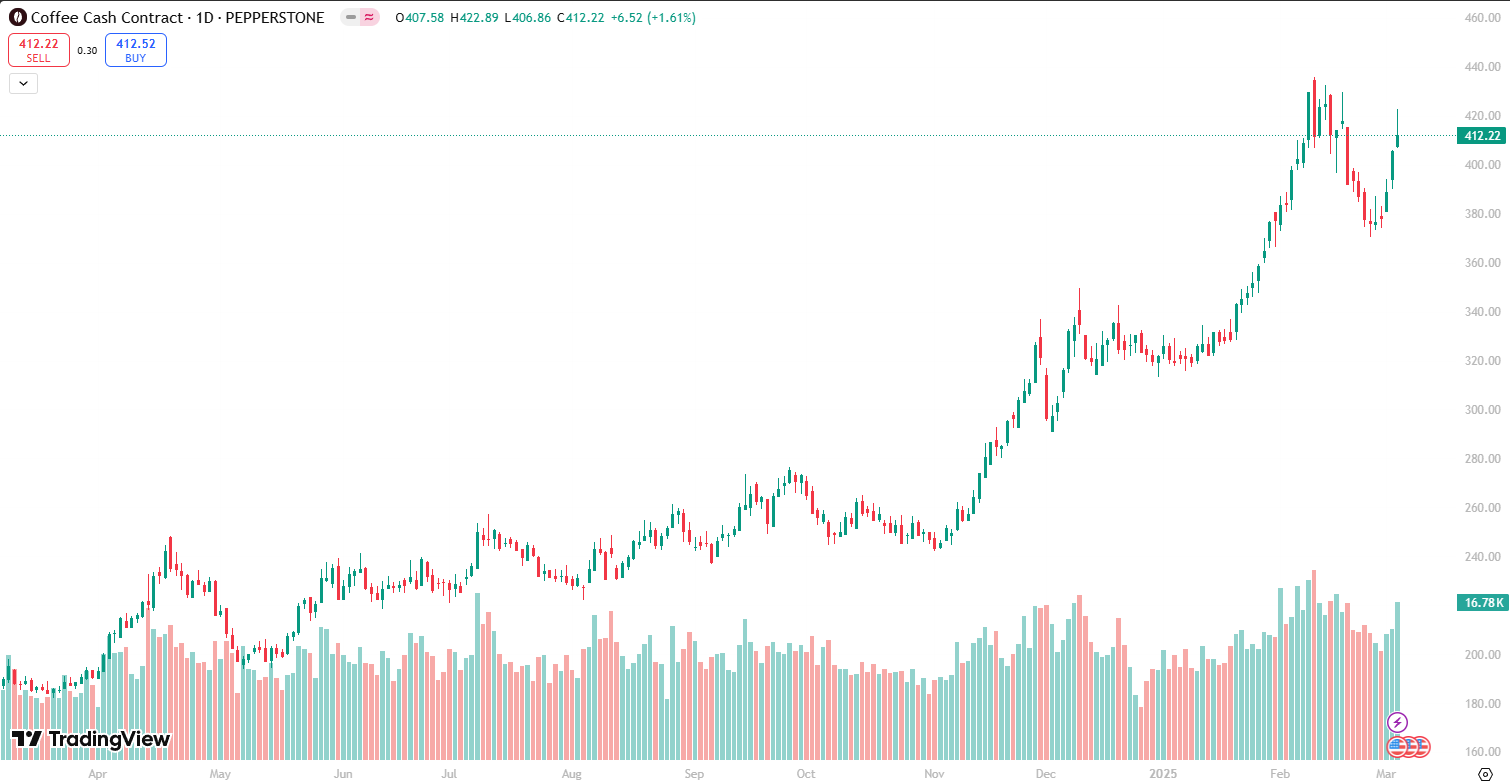
Image: The 12 month surge in the C-Price. Source: www.tradingview.com.au
Who’s Feeling the Pinch?
This price surge affects every player in the coffee supply chain:
Farmers & Producers: While higher prices might seem good, many farmers have already faced losses from poor harvests and rising costs.
Exporters & Importers: The cost of doing business is rising and there is greater risk, making it harder to secure quality beans.
Roasters: Roasters usually smooth prices for customers as the market fluctuates, but as the cost of green coffee has surged, they are forced to adjust prices or absorb losses.
Cafés: Higher bean prices, rent, wages, and milk and other operating costs are making it tougher to stay profitable in a very competitive market.
Coffee Drinkers: Prices are going up just as cost-of-living pressures increase. If your coffee hasn’t gone up yet, it likely will soon.
![]()
![]()
![]()
What’s Next?
Prices have been climbing for years, but recent extreme spikes mean roasters will need to adjust retail and wholesale prices. Many roasters lock in supply months in advance, delaying price increases. However, as existing stock runs out, new harvests must be bought at current market rates—meaning price hikes are inevitable.
Thankfully, small increases in cup prices can offset rising bean costs. But coffee is just one part of the cost of a cup—labour, rent, milk, and overheads are also climbing.
Currently, Australian coffee prices are lower than global benchmarks, so an adjustment may have been overdue.
Silver Linings – The Long-Term Outlook
While the future is uncertain, we see hope for some potential positives:
Better Prices for Farmers – Higher coffee prices (if they stabilise) will hopefully help farmers earn a fairer wage, especially in specialty coffee.
Industry Longevity – More sustainable prices could attract new generations of coffee farmers, ensuring long-term supply.
Focus on Sustainability – Climate change’s impact on coffee yields highlights the need for sustainable farming, research into crop resilience and waste reduction.
A Clearer Divide Between Cheap & Specialty Coffee – If consumers are paying more, they’ll demand better quality. The coffee industry will need to prioritise excellence to stand out.
![]()
![]()
![]()
Our Commitment to Quality
The entire coffee industry is facing rising costs. Roasters and cafés have two choices:
Option 1: Compromise on quality with cheaper coffee to keep prices low.
Option 2: Stay committed to great coffee quality and adjust prices to reflect true costs and value.
For us there is no choice, quality is non-negotiable.
We will:
- Continue sourcing the best coffee, even at higher costs.
- Be transparent about price changes and their reasons.
- Support cafés in educating customers on why quality matters.
Cheap coffee has never been sustainable—economically or environmentally. The specialty coffee industry thrives on passionate, informed customers who value great coffee and excellent hospitality.
What Can You Do?
Support the cafés and roasters who prioritise quality.
Your local café isn’t raising prices to take advantage of you—they’re just adapting to changes in their cost base to ensure their coffee sales remain viable. By choosing quality coffee, you’re supporting farmers, sustainability, and the future of specialty coffee.
Next time you sip your coffee, savour it—because good coffee is worth every cent.


